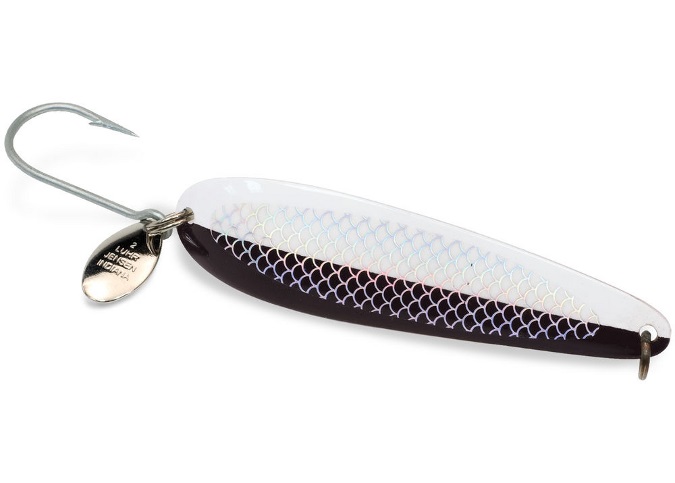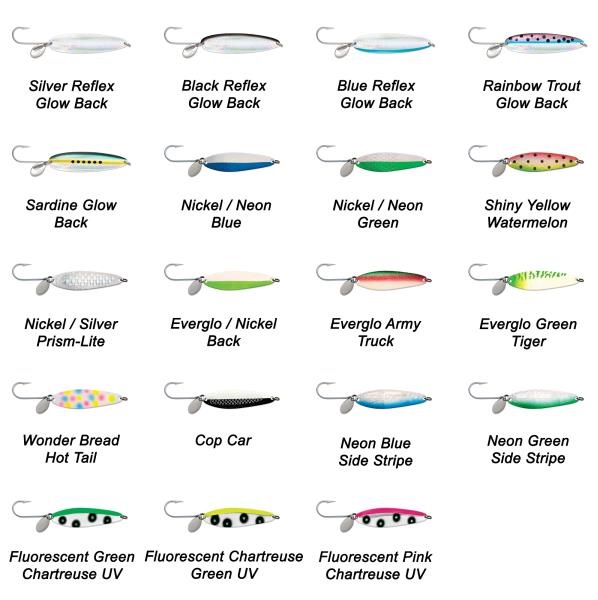Saltwater Salmon sport fishing takes place in an ever-changing environment. Conditions vary hourly, due to tide and current fluctuations, and the angler must be prepared to make instant revisions in tackle and/or fishing methods to be successful. One proven day-in and day-out saltwater fishing technique is trolling and one class of lures naturally geared for baitfish-eating Salmon is spoons. The combination of the two is a Salmon-catching technique considered unbeatable by many anglers . . . trolling spoons. Order Link >> https://www.rapala.com/luhr-jensen/luhr-jensen-new-arrivals/coyote-spoon/Coyote+Spoon.html?cgid=luhrjensen-newArrivals
The degree of success you’ll attain by trolling spoons for Chinook or coho Salmon will depend heavily on understanding the differences in habits and preferences between the two species and a knowledge of how tides and currents affect saltwater fish and fishing conditions.
Trolling with spoons is an extremely effective technique for both Chinook and coho Salmon because the lures closely resemble and imitate the action of crippled baitfish which make up a large part of the diet of Salmon and because a large amount of water can easily be covered in a short time.
A spoon should wobble from side to side and will produce the best all-around results when trolled at speeds between the slowest that produces a wobble and the fastest darting action which does not cause it to revolve or spin.
The following guidelines deal specifically with saltwater Salmon fishing and following them will yield optimum results. 
TIDES
A knowledge of tides and their effects is the #1 key to becoming a successful Salmon troller. Salmon feeding activity and fishing is best during the period from one hour before, through and for one hour after a tide change.
A 24-hour tide cycle has two highs and two lows so there are at least two daylight tide change periods to fish each day which provide optimum conditions. Charting one tide period, we would have low slack (the time of change), flood (run-in), high slack (change), ebb (run out) and back to low slack.
If the tide fluctuation is minimal between high and low, say 3 to 8 feet, baitfish and Salmon will be active throughout the tide cycle along rips, in eddies and many times in open water. But, the period before slack tide, during the slack and after still will provide you with top angling as Salmon will feed most actively when the don’t have to battle currents. You’ll have about three hours of prime fishing time around each change and it’s extremely important to fish these periods intensely.
Purchase a tide book for your area and become familiar with it and schedule your trips, if possible, to coincide with these change periods. Also, high tides provide the best launching and bar-crossing conditions in most bays and estuaries.
LOW LIGHT PERIODS
Although the time period around a tide change is considered best for fishing, two other times consistently produce Salmon . . . the low light periods of early morning and at dusk. During times when bright sunlight is not present, baitfish and Salmon often will be found within the top 30 feet of water. Combining a tide change period with one of these low light periods will produce the ABSOLUTE BEST CONDITIONS.
BIRDS/BAITFISH
Working birds are a good giveaway that baitfish are present and usually Salmon. The presence of seagulls or other surface-oriented birds indicates most bait is in the top 20 feet of water. Gulls and diving birds such as cormorants, in combination usually signal baitfish from 10 to 50 feet deep. Diving birds by themselves normally mean bait is deeper than 50 feet (surprising as it may seem, cormorants commonly dive up to 100 feet) If birds are not actively working, concentrate your efforts along the clean sides of rips or foam lines where conflicting currents come together, concentrating food.
TROLL WITH THE CURRENT
Salmon, as do other fish, always face into the current so troll with it rather than against it. By trolling with the current, you will constantly be presenting your spoon to Salmon from the front where it can easily be seen, rather than from behind where it can’t. when current is strong, Salmon also have a tendency to stay in areas where they don’t have to fight it. If the fish are stationary and you’re trolling against the tide and not covering new water, your chances for intercepting them are diminished. If trolling estuary areas, or in Puget Sound and the tide is running strong between changes, look for Salmon off points, in back eddy areas and troll zig-zag patterns because trolling with the tide is usually just too fast to be productive in this situation.
COLOR AND DEPTH
Both coho and Chinook can be very fickle when it comes to color, displaying a fondness for one color pattern at a particular time and then changing preference completely within a few hours or on a different day. How and what a Salmon sees is influenced by the amount of available light, water clarity and mood of the fish.
Colors change depending on depth. Red is filtered out of the light spectrum in about the first 30 feet, yellow and chartreuse at about 60 feet with green and blue the last to turn gray. White turns to gray at about 60 feet and black is always black, regardless of depth. Thus a deep water Salmon will see mostly blues, greens and dark shapes while a Salmon in shallow water will see all colors. When prospecting for Salmon, run spoons having red or metallic finishes toward the surface, yellow, chartreuse or Prism-Lite finishes at medium depths and greens and/or blue colors at the deepest level. Note: Blues and greens are effective at all depths because they imitate natural baitfish colors.
CHECK YOUR GEAR
Even if all other conditions are right, you won’t catch Salmon if your lure is tangled or has picked up weeds or jellyfish. Salmon, particularly big Chinook, are very wary of anything unnatural in the water. The best advice is to check your gear every 30 minutes (10 to 15 minutes if debris is present) to make sure it’s clean and running right.
KNOW THE AREA
Know everything you can about the area you’re going to fish BEFORE going out. Check with other anglers, baithouses, sporting goods stores, etc.
DOWNRIGGERS: Spoons often are fished off a downrigger, either by themselves or in conjunction with a dodger or flasher. With a downrigger you will be able to work all depths and will have the added advantage of no weights between you and the fish once hooked. Anglers who troll spoons by themselves behind a downrigger, especially when seeking wary fish such as Chinook, often prefer 10 to 20 feet (some as much as 40 to 60 feet) between line release and spoon.
Dodgers can be used as attractors in conjunction with a spoon behind a downrigger with good results. Size 0 or 1 Jensen Dodgers are recommended. Be sure to allow at least 6 feet of line between the dodger and downrigger line release so as not to inhibit the action of the dodger. Allow 18 to 25 inches of leader between your spoon and dodger (shorter leaders produce more frantic and faster spoon action; longer ones slower action).
Flashers such as the Abe ‘n Al® or are yet another kind of attractor which can be used with a spoon behind a downrigger. Flashers produce a deliberate, slow roll which often is favored by species such as Chinook. Because of the rotating nature of the flasher, spoons trailed behind must have more leader than that recommended for dodgers, such as 18 to 36 inches.
COHO VS. CHINOOK
There are big differences between Chinook and coho in their feeding habits, lure action preferences and habitat.
COHO: Coho Salmon generally can be found at depths less than 50 feet and commonly from the surface down to 30 feet. These are fast moving fish and they prefer spoons with a fast action as well as the increased attraction provided by a #0 or #00 dodger ahead of the spoon. They are wide-ranging and often can be found in open water, far away from structure. During low light periods, coho can be located feeding within a few feet of the surface or just along rip lines.
Specific spoons geared for medium to fast coho trolling include the Diamond King®, Tom Mack® Krocodile® and Coyote. Coho are known to strike a variety of color patterns with Chartreuse/Fishscale®, Glo/Fluorescent Green, Nickel/Neon Blue Stripe, Nickel/Neon Green Stripe, Mother of Pearl and Green/Chartreuse combinations the most popular. Basic metallic finishes of Brass, Chrome, 50/50 Brass/Chrome or Chrome/Blue also are productive. Prism-Lite® in Silver, Gold, Blue, Green or Red in combination with Chrome can be very effective.
CHINOOK: When compared with coho, Chinook prefer deeper water, larger spoons and slower action attractors. They often are caught in water from 60 to 120 feet or even deeper, especially during sunny, mid-day time periods.
There is a definite dawn bite associated with Chinook Salmon and a tide change period in association with first light is an optimum fishing time. Chinook often will shy away from any unnatural object or movement in the water so longer leaders and additional line out often are the rules. Proven spoons are the Krocodile®, Tom Mack®, Slow Sam and Point Defiance®. Mother of Pearl, Chartreuse/Fire Dot, 50/50 Chartreuse/Green and Glo finishes such as Glo/Green Stripe produce Chinook strikes regularly. When fish are found in shallow-to-medium depths, metallic finishes of Chrome, Chrome/Brass, either hammered or plain and the Prism-Lite® patterns are good choices. Metallic finishes of Chrome/Neon Blue Stripe, Chrome/Neon Green Strip and Prism-Lite® in Chrome/Blue, Chrome/Green and Chrome/Chartreuse combinations can be very effective medium-to-deep water Chinook patterns.
Both dodgers and flasher can be rigged with a spoon for Chinook trolling with good results. If using a rotating flasher, such as the Abe ‘n Al® or, be sure to use a longer leader than that used for a dodger. One 18 to 30 inches will produce a slow, deliberate action from the trailing spoon . . . one frequently favored by Chinook.
ADDITIONAL TIPS
One of the easiest and least complicated things you can do to improve your fishing results is to make sure all hook points are stick-sharp. The majority of lost fish can be traced to dull hooks with prevented proper penetration into the fish’s mouth. A small file such as Luhr Jensen’s Sharp Hook File is the absolute best hook sharpening tool available. Hold the file parallel to the hook point and, with gentle one-way strokes, remove a small amount of metal from at least two sides of the point. This results in both a sticky-sharp point and a knife-like cutting edge.
You should always use a premium quality monofilament line such as Trilene XT which has superior knot strength, small diameter in relation to pound test and which is abrasion resistant.
Purchase a quality depth sounder, such as one of the Lowrance units, which will help in locating fish as well as prime underwater fish-holding structure which can’t otherwise be detected. A paper chart recorder such as the X-15 will allow you to maintain a permanent record of structure areas and fish-holding level and will totally eliminate the guesswork.
